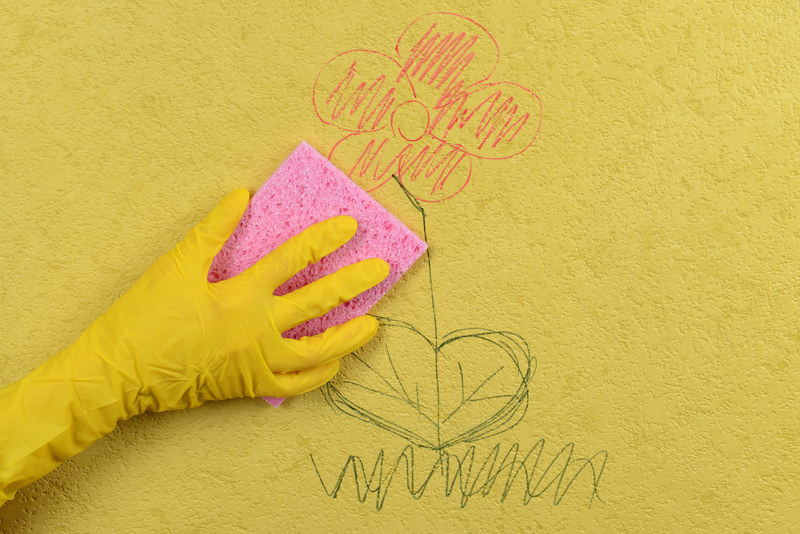Spill-Proof Tips for Maintaining Curtain Cleanliness
Posted on 18/06/2025
Curtains are more than just decorative window coverings; they play a crucial role in adding warmth, privacy, and style to any room. However, everyday life often brings its share of spills, splashes, and accidental stains, challenging homeowners to keep their curtains immaculate and fresh. Fortunately, adopting spill-proof tips for curtain cleanliness can prolong your curtains' life and keep your home looking beautiful.
Why Curtain Cleanliness Matters
Curtains, whether light sheers in the living room or thick drapes in a bedroom, are especially prone to dust, pet dander, food droplets, and beverage stains. Neglecting their cleanliness not only dulls your home's aesthetics but also triggers allergies and can harbor unpleasant odors. Maintaining clean curtains ensures a healthier indoor environment and enhances your home's overall appeal.

Common Curtain Spills and Stains
Before learning how to prevent spills, it's important to understand the typical curtain spill sources:
- Coffee, tea, or wine splashes from nearby tables.
- Condensation from drinks left on windowsills.
- Food fingerprints from children or pets brushing past.
- Mud or water from open windows during rain.
- Cosmetics and lotions from daily routines.
Key Principles of Spill-Proof Curtain Maintenance
Creating a curtain-friendly, spill-resistant home doesn't have to be daunting. With a combination of preventive measures, prompt action, and regular cleaning routines, you can keep your curtains spotless and extend their lifespan.
1. Select Easy-to-Clean Curtain Fabrics
The first line of defense is your curtain choice. Consider spill-resistant or machine-washable curtain materials for high-traffic areas and family rooms. Fabrics such as polyester, microfiber, or treated cotton are less likely to absorb stains and are easier to clean compared to silk or velvet.
- Microfiber: Repels moisture and stains due to dense weave.
- Polyester blends: Durable and generally safe for frequent washing.
- Outdoor fabrics: Sunbrella or similar materials boast water resistance and easy maintenance; ideal for kitchens and play areas.
2. Apply Fabric Protector Sprays
Pre-treating curtains with a quality fabric protector forms an invisible barrier against liquids and stains. Choose a reputable curtain stain repellent and apply according to manufacturer's instructions. Reapply every 6-12 months, especially after washing.
3. Practice Smart Placement and Arrangement
Strategic curtain placement is an effective spill-proof tactic:
- Avoid placing curtains too close to dining tables, kitchen counters, or kids' play zones.
- Shorten curtains in areas prone to splashes, such as kitchens and bathrooms, to reduce contact with liquids and grime.
- Tie back drapes during meal times, arts and crafts, or when using small appliances near windows.
4. Establish a Regular Cleaning Routine
Consistency is key for maintaining pristine curtain cleanliness:
- Vacuum weekly with a soft brush attachment to remove dust, crumbs, pollen, and pet hair.
- Spot clean stains immediately before they set, using mild detergent and cold water.
- Launder curtains as directed, usually every 3-6 months. Check manufacturer labels for fabric-specific care instructions.
5. Handle Spills Promptly: Step-by-Step Guide
Accidents happen, but prompt action can make the difference between a stubborn stain and spotless curtains. Here's how to deal with spills for optimal curtain hygiene:
- Blot, Don't Rub: Use an absorbent paper towel or clean cloth to gently blot excess liquid. Rubbing spreads the stain and pushes it deeper into the fabric fibers.
- Use Cold Water: Moisten a clean sponge with cold water and dab at the spill. Warm water can set stains, especially proteins like milk or blood.
- Mild Detergent Solution: Mix a few drops of gentle dishwashing liquid in a bowl of water. Apply a small amount to the affected area with a soft cloth, dabbing and rinsing until the stain lifts.
- Air Dry: Avoid excessive heat from hairdryers. Let the curtain air dry naturally to prevent shrinkage or further marking.
Additional Spill-Proof Curtain Tips for Busy Households
Busy families, homes with pets, and rental properties require extra vigilance. Adopt these curtain spill prevention strategies for extra protection:
Install Valances or Pelmets
Adding decorative valances or pelmets can catch airborne droplets and protect curtain tops from dust and stains, especially if air conditioning vents are nearby.
Keep Windowsills and Surroundings Clean
A clutter-free windowsill reduces the risk of spills from plants, drinks, or decorative items. Encourage household members to avoid placing food or liquids near windows.
Choose Dark or Patterned Fabrics
If your lifestyle makes immaculate curtains a challenge, opt for curtains in darker colors or busy patterns. These disguise minor stains and buy time between washes.
Teach Children and Guests Curtain Etiquette
- Remind little ones not to wipe their hands on curtains after snacking or playing.
- Encourage guests to use coasters and to take care with drinks near window treatments.
Rotate and Swap Curtains Regularly
If you have multiple sets of curtains, rotating them seasonally ensures even wear, allows for thorough cleaning, and reduces the risk of set-in stains in any one set.
Frequently Asked Questions About Spill-Proof Curtain Care
Q1: Can all curtains be made spill-proof?
While no curtain is truly completely spill-proof, selecting the right fabric and using protective treatments can significantly increase their resistance to stains and make cleaning much easier.
Q2: What's the best way to wash curtains?
Always check the care label. Most washable curtains can be cleaned in cold water with a gentle detergent. For delicate or structured drapes, professional dry cleaning is recommended.
Q3: How do I remove tough stains from curtains?
Treat tough stains with targeted stain removers designed for fabrics. Always test in an inconspicuous area first. For persistent stains, consult a curtain cleaning specialist.
Q4: How often should curtains be cleaned?
Vacuum weekly, spot-treat stains immediately, and wash every 3-6 months. Busy households or allergy sufferers may need more frequent cleaning.
Q5: Is it safe to use bleach on curtains?
Bleach can damage both fabric color and fibers. Instead, use a non-bleach stain remover or mild detergent, especially for colored or patterned curtains.
Top Products for Spill-Proof Curtain Maintenance
Enhance your curtain care routine with these useful tools:
- Fabric Protectors: Look for brands like Scotchgard or Guardsman for easy spray-on application.
- Upholstery Cleaning Sprays: Specialized cleaners can tackle specific stains without harsh chemicals.
- Handheld Steam Cleaners: Perfect for refreshing curtains and killing dust mites between washes.
- Soft Bristle Brushes or Attachments: Useful for gentle yet effective vacuuming of delicate fabrics.
Creating a Curtain Cleaning Schedule
A well-planned schedule keeps curtain care on your radar:
- Weekly: Light vacuuming and quick check for fresh spills.
- Monthly: Deeper vacuuming, spot-cleaning, and rearranging to distribute sun exposure evenly.
- Seasonally: Full laundering or professional cleaning, fabric protector re-application, and curtain swapping if possible.

The Benefits of Spill-Proof Curtain Practices
By following spill-proof curtain cleaning tips, you will enjoy:
- Longer-lasting, vibrant curtains thanks to reduced stain and sun damage.
- A healthier home environment free from dust, allergens, and mold.
- More time and money saved on costly curtain replacements or professional stain removal.
- Consistently welcoming and attractive rooms for family and guests alike.
Conclusion: Spill-Proof Confidence for Curtain Cleanliness
Maintaining curtain cleanliness and preventing spills doesn't have to be a hassle. With the right fabric choices, preventive measures, and effective cleaning routines, you can enjoy spotless, elegant curtains year-round. Adopt the above spill-proof tips for curtain care and transform your window coverings from a spill risk into a showcase of cleanliness and style.
Start today--assess your curtain placement, grab a protective spray, and enlist the whole household in simple spill-proof habits. Your rooms will thank you, and your curtains will continue to enrich your space for years to come!




